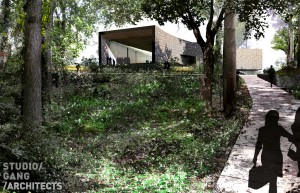
Kalamazoo College will host a ceremonial groundbreaking for its new Arcus Center for Social Justice Leadership building on October 9 at 4:00 PM. The ceremony, open to the campus community and general public, will take place on the corner of Academy St. and Monroe St. on the K campus.
The building’s architect, MacArthur Fellow Jeanne Gang, FAIA, founder of Studio Gang Architects in Chicago, will participate along with members of the College community.
Construction for the single-story, 10,000 sq. ft. building is scheduled to be completed in fall 2013 at a cost of $5 million—paid through a generous gift from K alumnus and trustee Jon Stryker.
The Arcus Center building is designed to create a space where K students, faculty, visiting scholars, social justice leaders, and members of the public will come together to engage in conversation and activities aimed at making a more just world.
The building’s three transparent façades—facing the campus, a grove of trees, and the surrounding neighborhood—are connected by curved walls constructed with wood masonry, a regional, traditional building method that incorporates Michigan grown, sustainably harvested white cedar. This is the first instance that this building technique, which is both low-carbon and highly insulating, has been employed for a project at an institutional scale. A LEED Gold certification is the construction target.
Studio Gang (www.studiogang.net), founded in 1997 by MacArthur Fellow Jeanne Gang, FAIA, is a collective of architects, designers, and thinkers whose work confronts pressing contemporary issues. The studio acts as a lab for testing ideas on varying scales: from cities to environments to material properties. Studio Gang’s work has been honored and exhibited widely, most notably at the International Venice Biennale, Museum of Modern Art, the Smithsonian Institution’s National Building Museum, and the Art Institute of Chicago.
Ms. Gang and members of her staff will discuss their innovative process of designing a building that facilitates the work of pursuing social justice in a dinner discussion on social justice leadership from 7-9 PM in the Hicks Center banquet room on the K campus. This free event is open to the public, but attendees must RSVP to Arcus Center Administrative Assistant Sholanna Lewis at slewis@kzoo.edu.
The Arcus Center for Social Justice Leadership (www.kzoo.edu/socialjustice) was launched in 2009 with support from the Arcus Foundation (www.arcusfoundation.org), including a $23 million endowment grant in January 2012.
Supporting Kalamazoo College’s mission to prepare its graduates to better understand, live successfully within, and provide enlightened leadership to a richly diverse and increasingly complex world, the new social justice center will develop new leaders and sustain existing leaders in the field of human rights and social justice.
Kalamazoo College (www.kzoo.edu), founded in Kalamazoo, Mich., in 1833, is a nationally recognized liberal arts college and the creator of the K-Plan that emphasizes rigorous scholarship, learning by practice, leadership development, and international and intercultural engagement. Kalamazoo College does more in four years, so students can do more in a lifetime.






 The Kalamazoo Institute of Arts has gone to the birds with a new exhibition, Birds of a Feather: John Costin and John James Audubon, featuring works loaned by the A.M. Todd Rare Book Collection at Kalamazoo College.
The Kalamazoo Institute of Arts has gone to the birds with a new exhibition, Birds of a Feather: John Costin and John James Audubon, featuring works loaned by the A.M. Todd Rare Book Collection at Kalamazoo College.